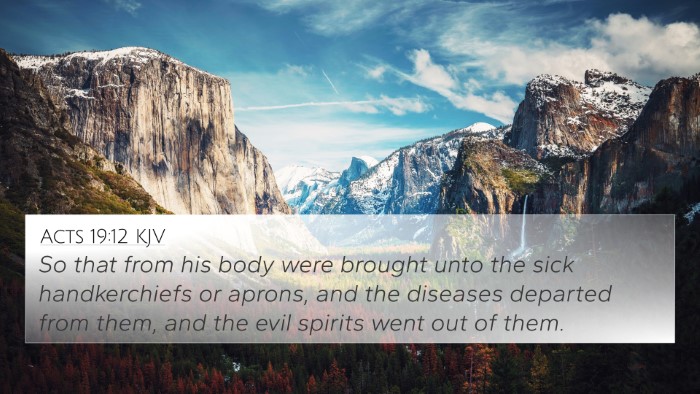Understanding Matthew 9:21
Matthew 9:21 states, "For she said within herself, If I may but touch his garment, I shall be whole."
This verse encapsulates the deep faith of a woman suffering from a chronic condition, highlighting themes of faith, healing, and the personal connection between individuals and Jesus Christ.
Contextual Insights
In the context of the Gospel, this passage occurs during a critical moment when Jesus is approached by Jairus, a ruler whose daughter is gravely ill. The woman described in this verse, who has been suffering from a menstruated issue for twelve years, believes that merely touching the hem of Jesus's garment can heal her. This reflects her desperate faith amidst social and religious hindrances.
Commentary Analysis
Matthew Henry's Commentary
Matthew Henry emphasizes the woman's faith and the boldness of her action. He notes that her determination to touch Jesus's garment was motivated by her belief that His power could heal her. Henry illustrates that it was not the garment itself that held the healing power but her faith in Jesus that activated it. He suggests that this story illustrates the principle that a little faith can lead to great miracles and highlights the accessibility of Jesus’s healing to those who earnestly seek Him.
Albert Barnes' Commentary
Albert Barnes reflects on the woman's internal monologue as a demonstration of her faith. He points to the importance of the phrase "said within herself," indicating that her belief was not reliant on public acknowledgement or ritual but was a personal conviction. Barnes underscores the power of faith to produce healing and suggests that her actions are an example of how individuals should approach Jesus—seeking Him with sincerity and confidence in His ability to heal.
Adam Clarke's Commentary
Adam Clarke focuses on the cultural and social implications of the woman's condition. He explains that she was ceremonially unclean and, therefore, ostracized. Despite her status, Clarke asserts that her faith allowed her to transcend social norms to reach Jesus. He highlights that her healing is representative of spiritual restoration, suggesting that social barriers cannot hinder an earnest seeker after God.
Thematic Connections
Matthew 9:21 can be cross-referenced with several other biblical verses to enhance understanding. Below are some connections that illustrate the recurring themes of faith, healing, and the personal relationship with Jesus.
- Mark 5:28 - This parallel verse gives insight into the woman's thoughts, aligning with her belief in being made whole through her faith.
- Luke 8:44 - A similar account in Luke adds depth, showing the immediate effect of the touch and the power emanating from Jesus.
- Matthew 14:36 - This passage describes others seeking to touch Jesus for healing, demonstrating a broader theme of faith enacted through contact.
- James 5:15 - Reflects the role of faith in healing, indicating that the prayer of faith will save the sick.
- Hebrews 11:1 - This verse defines faith as the substance of things hoped for and the evidence of things not seen, aligning with the woman’s belief.
- John 14:13-14 - Jesus promises that what we ask in His name, He will do, reinforcing the idea of seeking Him with faith.
- Isaiah 53:5 - Prophecies about healing and atonement connect Old Testament hope with New Testament fulfillment in Christ.
- Matthew 8:10 - Jesus commended the centurion's great faith, indicating that faith is essential for receiving God's grace.
- Romans 10:17 - Faith comes by hearing the Word of God, illustrating how the proclamation of God's Word builds faith, which the woman evidently had.
- Philippians 4:19 - Reassures believers that God will meet their needs, tying into the notion that Jesus is sufficient for healing and wholeness.
Lessons and Applications
The encounter encapsulated in Matthew 9:21 invites believers to reflect on the nature of their faith. It encourages a personal and sincere approach to Jesus, emphasizing that one’s faith can lead to profound transformation. Here are some practical applications:
- Seeking Jesus: Just as the woman sought to touch Jesus, individuals are encouraged to actively pursue their relationship with Him through prayer and worship.
- Faith over Fear: In the face of social stigma or personal struggles, faith can overcome obstacles, encouraging believers to be courageous in their faith journeys.
- The Power of Belief: Believing in Christ's power to heal—both physically and spiritually—reinforces the notion that faith is a powerful agent in the life of a believer.
- Community Support: Emulating the faith of the woman can inspire communities to support one another in faith and healing endeavors.
- Personal Reflection: Users are prompted to consider their internal dialogues and beliefs about Jesus and His ability to work in their lives.
Conclusion
Matthew 9:21 serves as a rich text for exploration, encouraging believers to connect deeply with their faith and highlighting the transformative power of Jesus. By understanding this passage in various contexts and linking it to other scriptural references, believers can appreciate the cohesive narrative of faith and healing throughout the Bible. The insights from public domain commentaries help readers grasp the significance of the woman’s faith and underscore the importance of a personal connection with Jesus.





